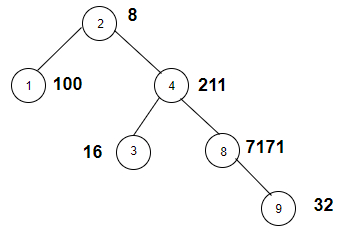
 Data Structure
Data Structure Networking
Networking RDBMS
RDBMS Operating System
Operating System Java
Java MS Excel
MS Excel iOS
iOS HTML
HTML CSS
CSS Android
Android Python
Python C Programming
C Programming C++
C++ C#
C# MongoDB
MongoDB MySQL
MySQL Javascript
Javascript PHP
PHPPhysics
Chemistry
Biology
Mathematics
English
Economics
Psychology
Social Studies
Fashion Studies
Legal Studies
- Selected Reading
- UPSC IAS Exams Notes
- Developer's Best Practices
- Questions and Answers
- Effective Resume Writing
- HR Interview Questions
- Computer Glossary
- Who is Who
Count the nodes in the given tree whose weight is a power of two in C++
Given a binary tree with weights of its nodes. The goal is to find the number of nodes that have weights such that the number is power of two. If weight is 32 then it is 25 so this node will be counted.
For Example
Input
The tree which will be created after inputting the values is given below −

Output
Count the nodes in the given tree whose weight is a power of two are: 3
Explanation
we are given with the tree node and the weights associated with each node. Now we calculate the power of each and every weight and check whether it can be expressed as power of 2 or not.
| Node | Weight | Weight^2 | Power of 2 |
|---|---|---|---|
| 2 | 8 | 2*2*2 | no |
| 1 | 100 | 10*2 | yes |
| 4 | 211 | Prime number | no |
| 3 | 16 | 4^2 | yes |
| 8 | 1717 | Not possible | no |
| 9 | 32 | 2*2*2*2*2 | yes |
Input
The tree which will be created after inputting the values is given below −

Output
Count the nodes in the given tree whose weight is a power of two are: 3
Explanation
we are given with the tree node and the weights associated with each node. Now we calculate the digit sum of each and every weight and check whether it's odd or not.
| Node | Weight | Weight ^ 2 | Power of 2 |
|---|---|---|---|
| 2 | 16 | 4^2 | yes |
| 1 | 141 | Not possible | no |
| 4 | 41 | Prime number | no |
| 3 | 64 | 8^2 | yes |
| 8 | 81 | 9^2 | yes |
Approach used in the below program is as follows −
In this approach we will apply DFS on the graph of the tree to traverse it and check if the weight of nodes is power of 2. Take two vectors Node_Weight(100) and edge_graph[100] for this purpose.
Initialize Node_Weight[] with the weights of nodes.
Create a tree using vector edge_graph.
Take a global variable sum and initialize it with 0.
Function power_two(int node, int root) takes a node and root node of a tree and returns the count of nodes in the given tree whose weight is power of two.
Take set = Node_Weight[node];
If set && (!(set & (set − 1))) returns true then it is power of two (bitwise AND and then negation)
Increment powers as set has a value which is power of 2.
Traverse tree in vector edge_graph[node] using for loop.
Call power_two(it, node) for the next node in the vector.
At the end of all functions we will have power as the number of nodes with weights having value as power of two.
Example
#include <bits/stdc++.h>
using namespace std;
vector<int> Node_Weight(100);
vector<int> edge_graph[100];
int powers = 0;
void power_two(int node, int root){
int set = Node_Weight[node];
if(set && (!(set & (set − 1)))){
powers++;
}
for(int it : edge_graph[node]){
if(it == root){
continue;
}
power_two(it, node);
}
}
int main(){
//weight of the nodes
Node_Weight[2] = 8;
Node_Weight[1] = 100;
Node_Weight[4] = 211;
Node_Weight[3] = 16;
Node_Weight[8] = 7171;
Node_Weight[9] = 32;
//create graph edge
edge_graph[2].push_back(1);
edge_graph[2].push_back(4);
edge_graph[4].push_back(3);
edge_graph[4].push_back(8);
edge_graph[8].push_back(9);
power_two(2, 2);
cout<<"Count the nodes in the given tree whose weight is a power of two are: "<<powers;
return 0;
}Output
If we run the above code it will generate the following output −
Count the nodes in the given tree whose weight is a power of two are: 3

